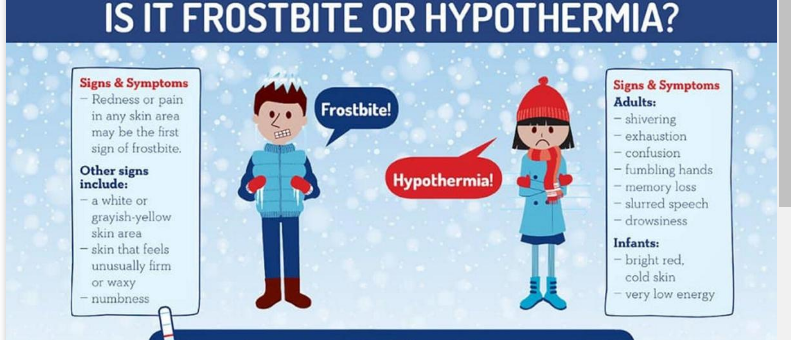As West Texas faces an intense cold snap with plummeting temperatures, it’s crucial for residents to be aware of the heightened risks of hypothermia and frostbite. Severe cold weather can pose serious threats to your health and safety if proper precautions are not taken. In this article, we will discuss the risks associated with hypothermia and frostbite, how to recognize their symptoms, and the essential first-aid steps to follow. By staying informed and prepared, you can protect yourself and your loved ones during this bitter cold spell.
Understanding the Risks:
When temperatures in West Texas plummet, the risk of hypothermia and frostbite becomes a significant concern. Hypothermia occurs when your body loses heat faster than it can produce it, causing your body temperature to drop dangerously low. Frostbite, on the other hand, is the freezing of the skin and underlying tissues, typically affecting extremities like fingers, toes, nose, and ears. Both conditions can have severe consequences if left untreated.

Recognizing Hypothermia Symptoms:
Hypothermia can set in when your body temperature drops below 95°F (35°C). It’s crucial to be vigilant for the following symptoms:
1. Confusion or memory loss.
2. Shivering, although severe cases may lead to diminished shivering.
3. Slurred speech.
4. Drowsiness or exhaustion.
5. Slow or shallow breathing.
6. Weak pulse.
7. Muscle stiffness or weakness.
If you or someone around you is experiencing these symptoms, it’s essential to take immediate action to prevent further complications.
First-Aid for Hypothermia:
If you suspect someone is suffering from hypothermia, follow these first-aid steps:
1. Move to a Warm Location: Get the person out of the cold and into a warm, dry area as quickly as possible.
2. Remove Wet Clothing: If the person’s clothes are wet, remove them and replace them with warm, dry clothing. Focus on keeping the head and neck covered.
3. Wrap in Blankets: Use blankets, towels, or any available insulation to wrap the person gently. Ensure their head and neck are covered.
4. Warm the Core: Use your own body heat or apply warm, dry compresses to the person’s torso, armpits, and groin. Do not use hot water, a heating pad, or a heating lamp, as this can cause burns.
5. Offer Warm Liquids: If the person is conscious and alert, provide warm, non-alcoholic, non-caffeinated beverages to help raise their body temperature.
6. Seek Medical Help: Hypothermia can be life-threatening, and it’s essential to seek immediate medical attention for the affected person.
Understanding Frostbite Symptoms:
Frostbite occurs when skin and underlying tissues freeze due to exposure to extremely cold temperatures.
Recognizing the symptoms of frostbite is crucial to prevent further damage:
1. Numbness or tingling in the affected area.
2. Hard, pale, or waxy-looking skin.
3. Pain or a burning sensation as the affected area thaws.
4. Swelling and blistering in severe cases.
First-Aid for Frostbite:
If someone shows signs of frostbite, take the following first-aid steps:
1. Get to a Warm Place: Move the person indoors or to a heated area immediately to prevent further exposure to cold temperatures.
2. Handle with Care: Do not rub or massage the frostbitten area, as this can cause further damage to the tissues.
3. Warm Water Soak: Submerge the frostbitten area in warm (not hot) water, ideally between 104-108°F (40-42°C), for 15-30 minutes. You can use a basin or tub for this purpose.
4. Pain Relief: Provide over-the-counter pain relievers, such as ibuprofen, to alleviate pain and inflammation, but avoid aspirin.
5. Elevate and Protect: Elevate the affected body part to reduce swelling, and protect it with clean, dry bandages.
6. Seek Medical Attention: Frostbite requires professional medical evaluation and treatment. Severe cases may result in tissue damage and complications.
General Cold Weather Safety:
In addition to recognizing the symptoms of hypothermia and frostbite and knowing how to respond, it’s essential to practice general cold weather safety:
1. Layer Clothing: Dress in layers to trap heat and insulate your body. Start with moisture-wicking fabrics close to your skin, followed by insulating layers, and finish with a windproof and waterproof outer layer.
2. Wear Proper Footwear: Insulated, waterproof boots with thermal socks are essential to protect your feet from frostbite.
3. Cover Exposed Skin: Use gloves, hats, scarves, and face masks to cover exposed skin, particularly the extremities.
4. Stay Dry: Wet clothing and skin lose heat more quickly, so stay dry by avoiding exposure to rain and snow.
5. Stay Informed: Monitor weather forecasts and stay updated on temperature changes and any weather warnings or advisories.
6. Limit Outdoor Activities: If possible, avoid prolonged exposure to extreme cold, especially during severe weather conditions.
Read More:
- Adan Canto: A Legacy of Versatility and Artistry in Film and Television
- Tragic Turn: Fatal Milk Truck Crash at California-Nevada Border Stirs Public Debate
- Bizarre Incident at Bass Pro Shops Alabama Man’s Nude Aquarium Dive Follows Car Crash
As West Texas experiences a severe cold spell with the potential for hypothermia and frostbite risks, it’s crucial to prioritize safety and preparedness. Understanding the symptoms of these conditions and knowing how to respond with first-aid measures can make a significant difference in preventing further complications. Additionally, adhering to general cold weather safety practices, such as layering clothing and staying informed, can help ensure your well-being during this bitter cold period. Stay warm, stay safe, and take care during the deep freeze!

